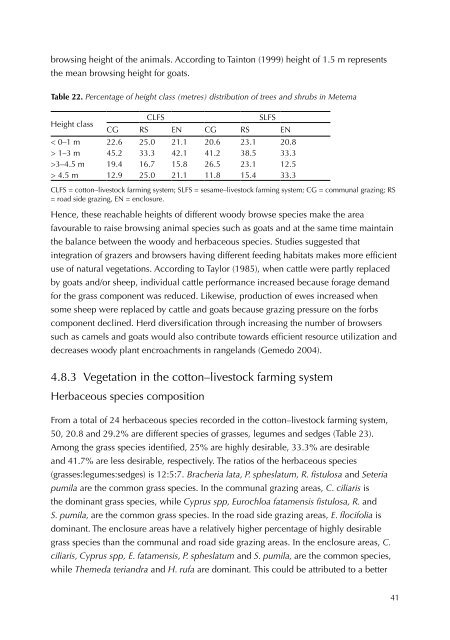Rangeland condition and feed resources in Metema District, North ...
Rangeland condition and feed resources in Metema District, North ...
Rangeland condition and feed resources in Metema District, North ...
You also want an ePaper? Increase the reach of your titles
YUMPU automatically turns print PDFs into web optimized ePapers that Google loves.
ows<strong>in</strong>g height of the animals. Accord<strong>in</strong>g to Ta<strong>in</strong>ton (1999) height of 1.5 m represents<br />
the mean brows<strong>in</strong>g height for goats.<br />
Table 22. Percentage of height class (metres) distribution of trees <strong>and</strong> shrubs <strong>in</strong> <strong>Metema</strong><br />
Height class<br />
CLFS<br />
SLFS<br />
CG RS EN CG RS EN<br />
< 0–1 m 22.6 25.0 21.1 20.6 23.1 20.8<br />
> 1–3 m 45.2 33.3 42.1 41.2 38.5 33.3<br />
>3–4.5 m 19.4 16.7 15.8 26.5 23.1 12.5<br />
> 4.5 m 12.9 25.0 21.1 11.8 15.4 33.3<br />
CLFS = cotton–livestock farm<strong>in</strong>g system; SLFS = sesame–livestock farm<strong>in</strong>g system; CG = communal graz<strong>in</strong>g; RS<br />
= road side graz<strong>in</strong>g, EN = enclosure.<br />
Hence, these reachable heights of different woody browse species make the area<br />
favourable to raise brows<strong>in</strong>g animal species such as goats <strong>and</strong> at the same time ma<strong>in</strong>ta<strong>in</strong><br />
the balance between the woody <strong>and</strong> herbaceous species. Studies suggested that<br />
<strong>in</strong>tegration of grazers <strong>and</strong> browsers hav<strong>in</strong>g different <strong>feed</strong><strong>in</strong>g habitats makes more efficient<br />
use of natural vegetations. Accord<strong>in</strong>g to Taylor (1985), when cattle were partly replaced<br />
by goats <strong>and</strong>/or sheep, <strong>in</strong>dividual cattle performance <strong>in</strong>creased because forage dem<strong>and</strong><br />
for the grass component was reduced. Likewise, production of ewes <strong>in</strong>creased when<br />
some sheep were replaced by cattle <strong>and</strong> goats because graz<strong>in</strong>g pressure on the forbs<br />
component decl<strong>in</strong>ed. Herd diversification through <strong>in</strong>creas<strong>in</strong>g the number of browsers<br />
such as camels <strong>and</strong> goats would also contribute towards efficient resource utilization <strong>and</strong><br />
decreases woody plant encroachments <strong>in</strong> rangel<strong>and</strong>s (Gemedo 2004).<br />
4.8.3 Vegetation <strong>in</strong> the cotton–livestock farm<strong>in</strong>g system<br />
Herbaceous species composition<br />
From a total of 24 herbaceous species recorded <strong>in</strong> the cotton–livestock farm<strong>in</strong>g system,<br />
50, 20.8 <strong>and</strong> 29.2% are different species of grasses, legumes <strong>and</strong> sedges (Table 23).<br />
Among the grass species identified, 25% are highly desirable, 33.3% are desirable<br />
<strong>and</strong> 41.7% are less desirable, respectively. The ratios of the herbaceous species<br />
(grasses:legumes:sedges) is 12:5:7. Bracheria lata, P. spheslatum, R. fistulosa <strong>and</strong> Seteria<br />
pumila are the common grass species. In the communal graz<strong>in</strong>g areas, C. ciliaris is<br />
the dom<strong>in</strong>ant grass species, while Cyprus spp, Eurochloa fatamensis fistulosa, R. <strong>and</strong><br />
S. pumila, are the common grass species. In the road side graz<strong>in</strong>g areas, E. flocifolia is<br />
dom<strong>in</strong>ant. The enclosure areas have a relatively higher percentage of highly desirable<br />
grass species than the communal <strong>and</strong> road side graz<strong>in</strong>g areas. In the enclosure areas, C.<br />
ciliaris, Cyprus spp, E. fatamensis, P. spheslatum <strong>and</strong> S. pumila, are the common species,<br />
while Themeda teri<strong>and</strong>ra <strong>and</strong> H. rufa are dom<strong>in</strong>ant. This could be attributed to a better<br />
41

















